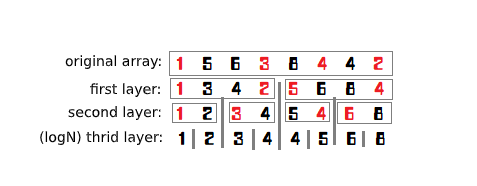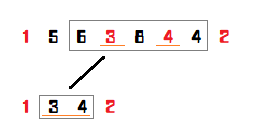Dividing Tree
The dividing tree is a data structure to solve the largest
It is recommended to finish learning Persistent Segment Tree before learning dividing tree
Tree construction¶
The construction of the dividing tree is relatively simple, but it is more complicated than other trees. 
As shown in the figure, each layer has a seemingly unordered array. In fact, every number marked in red is to be assigned to the left child. And the rules of distribution? The ones less equal to the median in this level are on the left, and the others are on the right. But here we should pay attention: it does not strictly follow left, otherwise right rule. Because the median may be the same, and it has a certain relationship with the parity of
We cannot sort each layer every time, because the theoretical complexity would not allow, not to mention the constants. To find the median, one pass sorting is enough. Why? For example, if we find the median of num[mid] after sorting.
There are two key arrays:
tree[log(N),N] : The tree, in which stores all the values, space complexity is $O(n\log n)$ .
toleft[log(N),n] : That is, the number of left child entered in each layer 1~i. Here we need to understand that this is a prefix sum.procedure Build(left,right,deep:longint); // left and right are intervals; deep is which layer we are currently on
var
i,mid,same,ls,rs,flag:longint; // flag is used to balance the amount on the left and right
begin
if left=right then exit; // reach the bottom layer
mid:=(left+right) >> 1;
same:=mid-left+1;
for i:=left to right do
if tree[deep,i]<num[mid] then
dec(same);
ls:=left; // first pointer assigned to the left child
rs:=mid+1; // first pointer assigned to the right child
for i:=left to right do
begin
flag:=0;
if (tree[deep,i]<num[mid])or((tree[deep,i]=num[mid])and(same>0)) then // condition to be assigned to the left
begin
flag:=1; tree[deep+1,ls]:=tree[deep,i]; inc(ls);
if tree[deep,i]=num[mid] then // balance the number nodes in left and right sides
dec(same);
end
else
begin
tree[deep+1,rs]:=tree[deep,i]; inc(rs);
end;
toleft[deep,i]:=toleft[deep,i-1]+flag;
end;
Build(left,mid,deep+1); // continue
Build(mid+1,right,deep+1);
end;Querying¶
Let's first talk about the content of the persistent segment tree. When using the persistent segment tree to find the smallest
What makes the query difficult to understand is the interval reduction. In the figure below, we are querying from

function Query(left,right,k,l,r,deep:longint):longint;
var
mid,x,y,cnt,rx,ry:longint;
begin
if left=right then // It doesn't hurt to write l=r, because the target interval must also have an answer
exit(tree[deep,left]);
mid:=(l+r) >> 1;
x:=toleft[deep,left-1]-toleft[deep,l-1]; // number of left child from l to left
y:=toleft[deep,right]-toleft[deep,l-1]; // number of left child from l to right
ry:=right-l-y; rx:=left-l-x; // ry is the number of right child from l to right, and rx is the number of right child from l to left
cnt:=y-x; // number of child node from left to right
if cnt>=k then // typical persistent segment tree
Query:=Query(l+x,l+y-1,k,l,mid,deep+1) // l+x is to reduce the left margin, l+y-1 is to reduce the right interval. For the above figure, it is to give up nodes 1 and 2.
else
Query:=Query(mid+rx+1,mid+ry+1,k-cnt,mid+1,r,deep+1); // the same is to narrow the interval, but it becomes the right side. Pay attention to k-cnt.
end;Theoretical complexity and testing results¶
Time complexity: one query only needs
Space complexity: only need to store
Testing results: persistent segment tree:
Notes¶
You may also want to try implementing a non-recursive version. (Original link in Chinese)
buildLast update and/or translate time of this article,Check the history
editFound smelly bugs? Translation outdated? Wanna contribute with us? Edit this Page on Github
peopleContributor of this article Xarfa
translateTranslator of this article Visit the original article!
copyrightThe article is available under CC BY-SA 4.0 & SATA ; additional terms may apply.